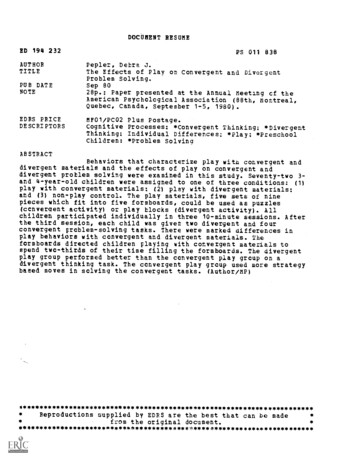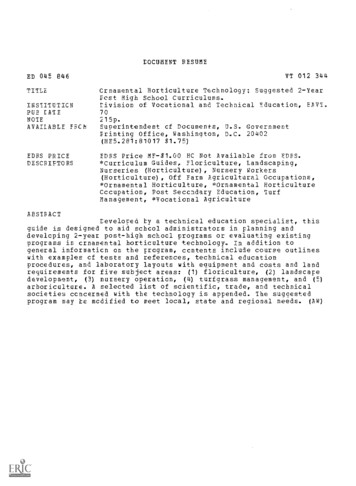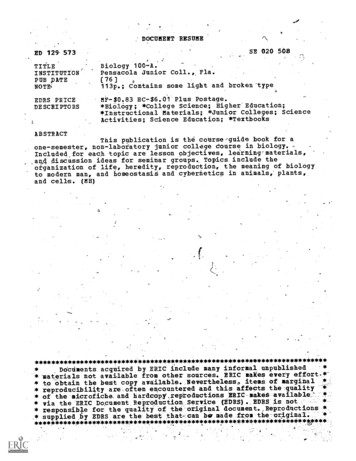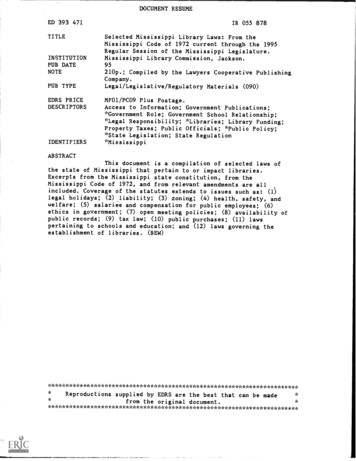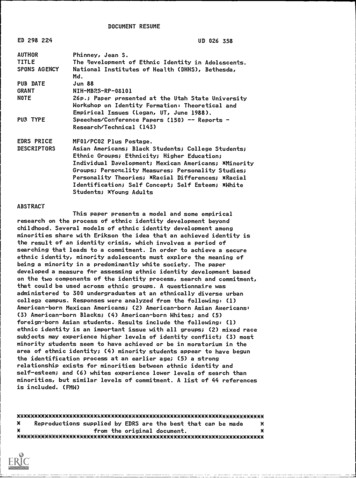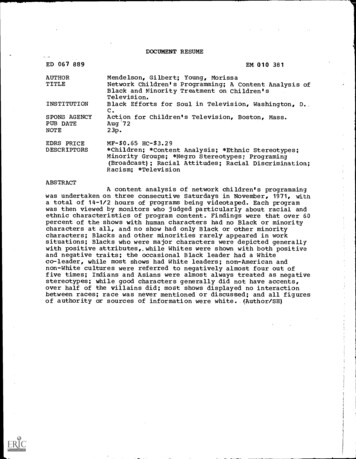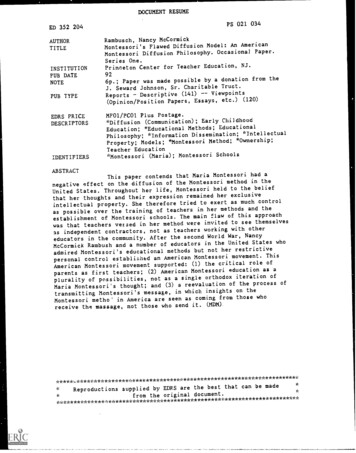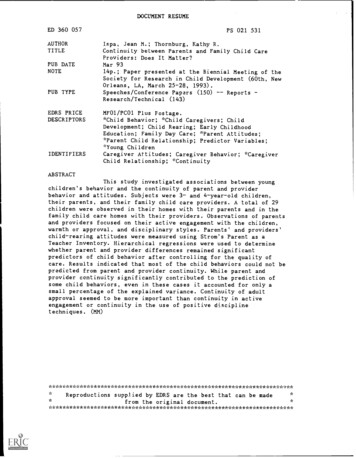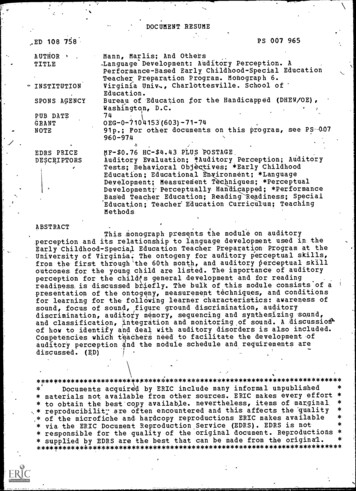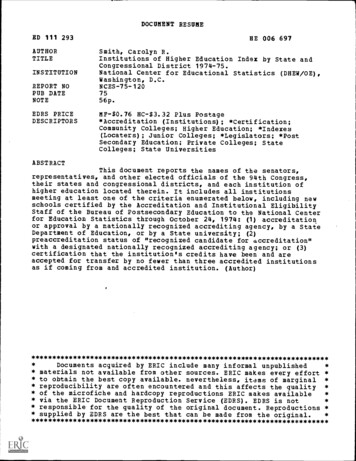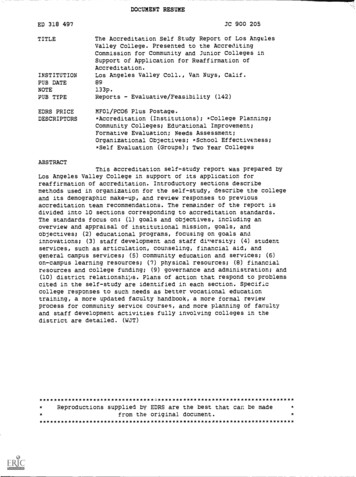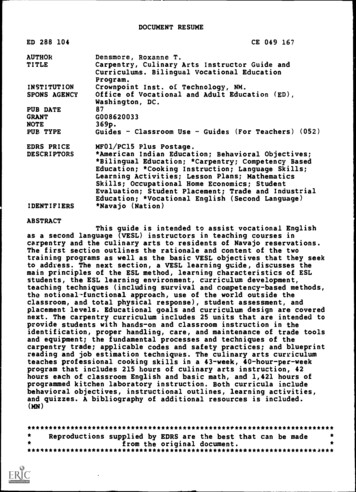
Transcription
DOCUMENT RESUMEED 288 104AUTHORTITLEINSTITUTIONSPONS AGENCYPUB DATEGRANTNOTEPUB TYPEEDRS PRICEDESCRIPTORSIDENTIFIERSCE 049 167Densmore, Roxanne T.Carpentry, Culinary Arts Instructor Guide andCurriculums. Bilingual Vocational EducationProgram.Crownpoint Inst. of Technology, NM.Office of Vocational and Adult Education (ED),Washington, DC.87G008620033369p.GuidesClassroom UseGuides (For Teachers) (052)MF01/PC15 Plus Postage.*American Indian Education; Behavioral Objectives;*Bilingual Education; *Carpentry; Competency BasedEducation; *Cooking Instruction; Language Skills;Learning Activities; Lesson Plans; MathematicsSkills; Occupational Home Economics; StudentEvaluation; Student Placement; Trade and IndustrialEducation; *Vocational English (Second Language)*Navajo (Nation)ABSTRACTThis guide is intended to assist vocational Englishas a second language (VESL) instructors in teaching courses incarpentry and the culinary arts to residents of Navajo reservations.The first section outlines the rationale and content of the twotraining programs as well as the basic VESL objectives that they seekto address. The next section, a VESL learning guide, discusses themain principles of the ESL method, learning characteristics of ESLstudents, the ESL learning environment, curriculum development,teaching techniques (including survival and competency-based methods,the notional-functional approach, use of the world outside theclassroom, and total physical response), student assessment, andplacement levels. Educational goals and curriculum design are coverednext. The carpentry curriculum includes 25 units that are intended toprovide students with hands-on and classroom instruction in theidentification, proper handling, care, and maintenance of trade toolsand equipment; the fundamental processes and techniques of thecarpentry trade; applicable codes and safety practices; and blueprintreading and job estimation techniques. The culinary arts curriculumteaches professional cooking skills in a 43-week, 40-hour-per-weekprogram that includes 215 hours of culinary arts instruction, 42hours each of classroom English and basic math, and 1,421 hours ofprogrammed kitchen laboratory instruction. Both curricula includebehavioral objectives, instructional outlines, learning activities,and quizzes. A bibliography of additional resources is **********************************Reproductions supplied by EDRS are the best that can be madefrom the original ******************************
BILINGUAL VOCATIONAL EDUCATION PROGRAMCrownpoint Institute of TechnologyInstructor Guide and CurriculumsforCARPENTRYCULINARY ARTSGloria Arviso: Bilingual Vocational Education Project DirectorRoxanne T. Densmore: Program Consultant Evaluator and Curriculum Writerfor the Bilingual Vocational Education ProjectU S DEPARTMENT OF EDUCATIONOffice of Educational Research and ImprovementED CATIONAL RESOURCES INFORMATIONERIC)has been reproduced asreceived from the person or orgarfizafiongfiginating It0 Minor changes have been made to improveThis documentreproduction dualltyPomts of view or opmons stated tn IhtsdoCument do not necessarily represent of finalOERI position or policyr)4BEST COPY AVAILABLE
NEW MEXICOCrownpoint Institute of TechnologyTitle:Bilingual Vocational Education TrainingLanguage group served:Na-rahoOccupational areas:Carpentry and Culinary ArtsLength of training:11 monthsNumber of training cycles:1 1/2Weekly hours of vocational training:Weekly hours of ESL:6 hoursHours of job counseling:4 hoursGrant award amount: 203,805Number of trainees:45Approximate cost per .trainee:Coordinating agency:Project Director:Address:Phone: 4,529JTPAGloria ArvisoP.O. Drawer KCrownpoint, New Mexico(505)786-5851Project runs until August 31, 1987G0086 2003330 hours87313
TABLE OF CONTENTSIntroduction to Bilingual Vocatic,Aal Education ProgramPg.1-9English as a second Language Instructor GuidePg.11-54III.Educational GoalsPg.55-56IV.Curriculum DesignPg.56-60Carpentry CurriculumPg.61-213Culinary Arts II.
PHILOSOPHY STATEMENTThe Crnwnpnint Institute of technology as a primarily Navajoinstitution reflects the area's culture and Navajo language.part of an individual's identity and sense of self worth.Language isLanguage is atthe very core of cultural values and provides the "wheels" for itstransmission from one generation to another.serves as a mirror of reality.For the Navajo, languageThE native Navajo language becomes a vehicleor means for the Navajo student to understand and relate to the dominatesociety.The CIT staff feels that people's lives are important and thatnative people are entitled to exercise in the setting of where they livetheir cultural valises and their native language.They are also entitled toan education including English proficiency to ensure their personal economicself sufficiency and social well being.Test results and studentperformance have shown that the CIT student has limited Englishproficiency.This becomes an economic handicap in today's job market; onethat can and must be directly addressed.This becomes the unique problemvocational training programs on the reservation must solve.PROGRAM DESCRIPTIONCIT's answer to the situation includes the Culinary Arts vocationalinstructor with expertise, the VESL instructor and a bilingual aide.Classes consist of students ages nineteen to forty seven.They are allmembers of the Navajo tribe who learned Navajo as their first language.English was learned and used in a school setting and Navajo was the languageto be used at home and with friends and relatives.As a result of thehistorical situation for the Navajo, many have limited proficiency in bothEnglish and Navajo.with both languages.Most conversations by a native speaker are sprinkledThe fact that such a group can exist within the2o
continental United States in difficult for mainstream Americans tounderstand.The Crownpoint Institute of Technology serves Navaio studentswho are looking primarily for educational and employment opportunities on ornear the reservation.The bilingual aide serves a special function in the program as she hasgone through the Culinary Arts training herself as a student and hasShe is always with the students inworked in the CIT cafeteria as a cook.the class and in the kitchen.Concepts or instructions that a student maynot understand are translated into Navajo for the student by her.The Culinary Arts vocational program offers hands on training in theCIT cafeteria which serves CIT students, staff, and the general public.The training simulates on the job training leading to first day productivityfor graduates.The vocational curriculum includes needed entry level skillsin the commercial food service industry such as safety and sanitationprocedures, proper use of hand tools and stationary equipment, foodpreparation methods and techniques, and basic kitchen operation procedures.Career instruction includes a sampling of entry level jobs in food service,filling out job application, writing letters of application and resumes.Attitude, punctuality reliability, cooperation and team work are among theimportant job values stressed in the program.English is used as much as possible for instruction.In fact, neitherthe vocational instructor nor the VESL instructor speak Navajo.Instead,they rely on previous experience in teaching on the reservation and theassistance of the aide as needed.The English instruction focuses on jobrelated language structures and vocabulary.English is often a confusinglanguage to learn full words an,: multiple meanings.would be the work, "dressing."An example of thisIn Culinary Arts alone this word can can be36
IIIIused to mean three different concepts--a sauce for a salad, a stuffing forpoultry and a cleaning process for freshly caught fish.In addition, manytrade related vocabulary items are French in origin, examples include GardeManager, Sous Chef, quiche, bouquet garni, and a la carte.Students are expected to be familiar with professional methods ofmeasurement and recipe conversion techniques.To achieve this end,instruction includes basic math skills and vocational math.Students areoffered experience in cashiering, inventory methods, and menu costingprocedures.Unlike some bilingual vocational programs, CIT students mustlearn about food preparation as it is practiced in everyday Americanrestaurants.They can no longer learn only a minimum level of English andwork in a specialty restaurant serving only Navajo cuisine as many LEPChinese students can do who eventually intend to be employed in Chineserestaurant.Provision is made in the program design for vaiying levels ofachievement.Efforts are made to help students learn how to learn.guides based on the textbook and study techniques are stressed.StudyTo helpthose with special problems, individual tutoring time is scheduled asneeded.Instrumental Enrichment is also offered with the primary goal ofachieving cognitive modifiability.This curriculum guide has been prepared by the staff of the CrownpointInstitute of Technology for Navajo students in the Culinary Arts andCarpentry program, which is a part of the bilingual vocational trainingprogram instituted and developed in 1987. (year).The quality and professionalism of the staff and curriculum, theprogram's relationship to training and placement in the field, the actualcontemporary facilities and equipment, including the selection of students
that will benefit from the curriculum, and the workability, practicality ofprogram are multi-fold and becoming indispensable to the overall currocs Andproductivity of the program.The second courses, outline and content of the curriculum is aninstrumental aspect of the program planning as it includes goals, behavioralobjectives, strategies, logistics and evaluation.The curriculum focusesupon the trainee, the vocational skills to be learned and determines theparticular demands of the current job market.The individualized programfactors determine the needs of the population it will serve.Specific andgeneral objects in relation to educational goals and philosophy have beenstated and designed to included vocational and language skills, withemployability components integrated.The training cycle includes:1) Conducting a model bilingual culinary and carpentry program tobenefit adults with extremely limited English proficiency, little formaleducation and to assist the individuals in the area of employment in therestaurant or related industry which includes orientation to Americanculture, attitudes and way of living.The vocational course of the Crownpoint Institute of Technologyemphasizes basic preparation, cooking and safety skills necessary for thepreparation of foods in the Culinary Arts program and emphasis in theCarpentry program includes introduction and preparation for entry in theconstructional trade requiring semi-skilled knowledge and training.Culinary includes analysis and recognition of foods, methods,ingredients, nomenclature, cooking methods and the deployment of dishesthat are served, including garnishing and decoration.Roles of kitchenstaff, basic rules of safety and sanitation constitutes part of the training5
cycle.Carpentry includes detailed coverage of all aspects of light frameIncluded are site cleaning, site layout, foundations,construction.framing, sheathing, roofing, windows and doors, exterior furnish, interiorwall floor an ceiling finish.Special emphasis is placed on the use ofmodern tools & materials.SAFETY,APPLICATION FOR ABasicinstructionalunits should LFRAMING,WALLANDROOF MATERIALS AND APPLICATION.-Carpentry:Prepares students for jobs currently existing in the tradewith emphasis in framing, foundations, exterior finish, insulation andinterior finish.-Masonry:Training includes experience in site layout, concreteforming/pouring/finishing, block and brick laying, plastering, casting sillsand lintels.-Residential, Commercial Plumbing/Pipe Fitting:Experiences include manyphases of systems rough-in, hookups for residential systems, fixture andappliance installation and systems maintenance and repair.Training consists of work performed-Censtru:tion/Maintenance Electric:an:in areas of residential, commercial and industrial electrical installation.The National Electrical Code is also covered.Surv'ying Aide:Provides job skills in areas of highway, construction andland surveying.-Heavy Equipment Mechanics:Emphasis is in the areas of maintenance,operation, overhaul, fuel and electrical system, and hydraulics on a varietyof diesel and gas-powered equipment.-Architectural Drafting:The CIT Architectural Drafting course is designed69
to enable students to seek employment as entry level drafters with aBasic Drafting 1 and Basicspecialization in architectural drafting.Drafting II will comprise tha core of the program into which ArchitecturalDrafting will be integrated.The students will also receive training inuses of Computer Aided Drafting.--Sheet Metal:The CIT Sheet Metal course will prepare students who plancareers in sheet metals with better than entry level skills.The coursewill provide instruction in sheet mental processes performed with handtools, cutting and layout tools.It will teach safety, cai-e of tools andequipment, straight pattern development and fabrication.The training willincluded lab projects oriented to installation of heating and ventilationcomponents.The basic VESL objectives inherent in the program are to provide thelearners with English communication skills required not only in coursework,but necessary in the job market and for coping with life and employment inthe American employment mainstream.In Culinary Arts and in themar
Institute of Technology for Navajo students in the Culinary Arts and Carpentry program, which is a part of the bilingual vocational training program instituted and developed in 1987. (year). The quality and professionalism of the staff and curriculum, the program's relationship to training and placement in
